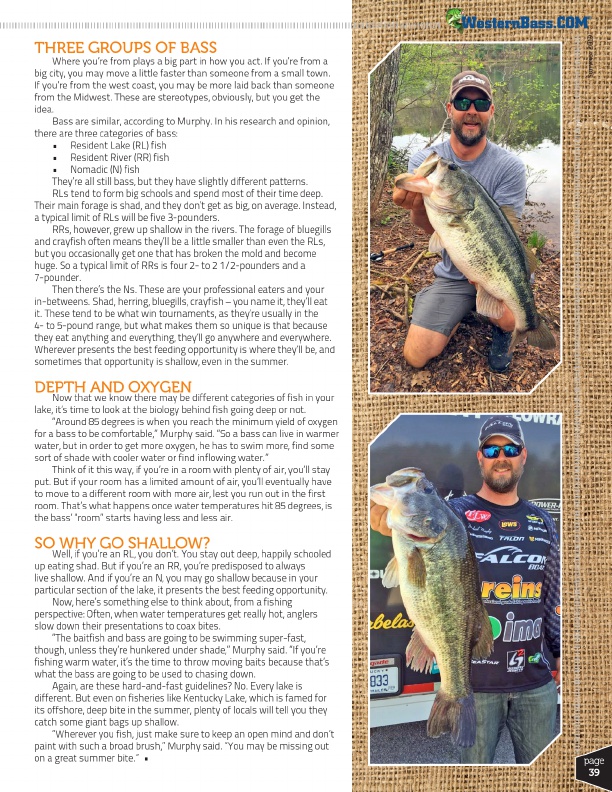
THREE GROUPS OF BASS
Where you’re from plays a big part in how you act. If you’re from a big city, you may move a little faster than someone from a small town. If you’re from the west coast, you may be more laid back than someone from the Midwest. These are stereotypes, obviously, but you get the idea.
Bass are similar, according to Murphy. In his research and opinion, there are three categories of bass:
• Resident Lake (RL) fish
• Resident River (RR) fish
• Nomadic (N) fish
They’re all still bass, but they have slightly different patterns.
RLs tend to form big schools and spend most of their time deep. Their main forage is shad, and they don’t get as big, on average. Instead, a typical limit of RLs will be five 3-pounders.
RRs, however, grew up shallow in the rivers. The forage of bluegills and crayfish often means they’ll be a little smaller than even the RLs, but you occasionally get one that has broken the mold and become huge. So a typical limit of RRs is four 2- to 2 1/2-pounders and a 7-pounder.
Then there’s the Ns. These are your professional eaters and your in-betweens. Shad, herring, bluegills, crayfish – you name it, they’ll eat it. These tend to be what win tournaments, as they’re usually in the 4- to 5-pound range, but what makes them so unique is that because they eat anything and everything, they’ll go anywhere and everywhere. Wherever presents the best feeding opportunity is where they’ll be, and sometimes that opportunity is shallow, even in the summer.
DE N P o T w H that A w N e k D now O th X er Y e m G a E y b N e different categories of fish in your
lake, it’s time to look at the biology behind fish going deep or not.
“Around 85 degrees is when you reach the minimum yield of oxygen for a bass to be comfortable,” Murphy said. “So a bass can live in warmer water, but in order to get more oxygen, he has to swim more, find some sort of shade with cooler water or find inflowing water.”
Think of it this way, if you’re in a room with plenty of air, you’ll stay put. But if your room has a limited amount of air, you’ll eventually have to move to a different room with more air, lest you run out in the first room. That’s what happens once water temperatures hit 85 degrees, is the bass’ “room” starts having less and less air.
SO W W ell, H if y Y ou’r G e a O n R S L, H you A d L on L ’t O . Yo W u s ? tay out deep, happily schooled
up eating shad. But if you’re an RR, you’re predisposed to always live shallow. And if you’re an N, you may go shallow because in your particular section of the lake, it presents the best feeding opportunity.
Now, here’s something else to think about, from a fishing perspective: Often, when water temperatures get really hot, anglers slow down their presentations to coax bites.
“The baitfish and bass are going to be swimming super-fast, though, unless they’re hunkered under shade,” Murphy said. “If you’re fishing warm water, it’s the time to throw moving baits because that’s what the bass are going to be used to chasing down.
Again, are these hard-and-fast guidelines? No. Every lake is different. But even on fisheries like Kentucky Lake, which is famed for its offshore, deep bite in the summer, plenty of locals will tell you they catch some giant bags up shallow.
“Wherever you fish, just make sure to keep an open mind and don’t paint with such a broad brush,” Murphy said. “You may be missing out on a great summer bite.” •
®
Summer 2019
page
39